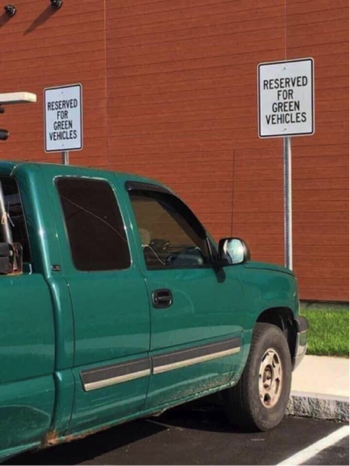What Does It Take to Message Effectively? The 'Reserved for Green Car' Case Study
Suppose you were a cop and you came across the situation in this photo. Would you issue a citation for a parking violation? If the case went to court, and you were the judge, would you rule for or against the defendant?

I'm not a lawyer, but common sense suggests that the driver almost certainly violated the intent of the rule. Maybe because drivers are licensed, they are expected to correctly intuit the proper interpretations of traffic signs. But turning to business, how many of your end customers and workers are licensed to do what they do?
Let me make these important points:
- Messaging matters. Mess up the communication about guidance, and transactions (let's say that in the present context the act of parking a vehicle is a transaction) can easily go astray.
- Message makers (in this case, the sign designer) should not be left on their own when it comes to creating guideposts for operational activity. Those of you who are business analysts and IT professionals are sign makers in more ways than one. So yes, if you're reading this, that probably means you.
- It's not enough to simply establish rules. Messaging about the rules is also part of the equation. And it's true whether or not the rule can be automated.
Let's be clear about what kind of messaging I mean. All the following are involved:
- Selection of Term. Clearly the term 'green vehicle' could be ambiguous. Did the business people (state highway or local traffic officials) foresee that? Should they have thought through its usage in the constrained real estate of likely communication channels (here the size of the sign) more thoroughly? Should business analysts or other professionals have given them a heads-up about this potential problem in advance? I'd say the answer to all these questions is yes.
- Definition of Concept. What is the meaning of 'green vehicle'? Is the concept defined clearly? Is it defined somewhere that is accessible for people who need it (e.g., the driver of this vehicle)? Let's assume the driver of the pick-up truck is a righteous citizen. Could they find the definition in real time? For example, would it work to post the definition on the back of the sign? What's the feasibility of an app for that?
- Short-Handing the Rule. Apart from the problem with 'green vehicle', does "Reserved for Green Vehicles" best support the messaging? Would 'Green Vehicles Only' be better?[1] A before-implementation-time conversation about the best form of the message should directly involve business stakeholders.
- Expressing the Policy. If you unravel this ball of yarn completely, ultimately you get to the long-hand expression of the parking law or regulation in an authoritative source. That's the ultimate source of the truth. Without ever considering that source text directly, it's hardly surprising you'd go astray in implementation.
A little backstory: I put this photo out on social media and posed essentially the same questions as earlier. A flood of replies came back, most of which in one way or another had to do with requirements.
Hold on! Where did I say anything about requirements?! Frankly, I think the relevant 'requirements' were probably satisfied by this implementation — a sign was visibly posted for the reserved spot. The real problem was not with the requirements; it was with the (business) messaging.
Let me make that last point more strongly. Talking 'requirements' when the issue is policy and rules is way off-target. Rules are rules, and requirements are requirements. First there are rules, then there are requirements. Why shouldn't business analysts engage directly with the (original) rules themselves, along with the associated terminology and messaging? No-brainer!
Ask yourself: Is your own requirements approach friendly to vocabulary, policies, and messages? I mean directly. Wouldn't it be of great help to your organization in achieving its goals (not just build IT systems) if it were? In our experience, policy sources almost always need interpretation and disambiguation to achieve an effective practicable form. 'Reserved for Green Car' is a great case in point.[2]
In the knowledge age, the messaging component of any business problem space simply cannot be ignored.[3] In a digital world very seldom will there be any flesh-and-blood cop on the spot when it comes time for a metaphorical 'don't do that'.
References
[1] In our RuleSpeak® we have a strong preference for 'only'.
[2] These are key components of the BRSolutions Professional Training Suite: https://brs1on1.com/order/. Take a 10-minute pinpoint assessment to determine whether this training could be helpful for you and your company: https://brs1on1.com/.
[3] I talk more about Business Messaging in my most recent two columns:
- Ronald G. Ross, "Rethinking Your Business Messaging Space: Knowledge Alignment," Business Rules Journal, Vol. 22, No. 9, (Sep. 2021), URL: http://www.brcommunity.com/a2021/c075.html
- Ronald G. Ross, "Ownership of Vocabulary vs. Ownership of Data: A Fresh Look from the Business Messaging Perspective," Business Rules Journal, Vol. 22, No. 10, (Oct. 2021), URL: http://www.brcommunity.com/a2021/c078.html
# # #
About our Contributor:
Online Interactive Training Series
In response to a great many requests, Business Rule Solutions now offers at-a-distance learning options. No travel, no backlogs, no hassles. Same great instructors, but with schedules, content and pricing designed to meet the special needs of busy professionals.










How to Define Business Terms in Plain English: A Primer
How to Use DecisionSpeak™ and Question Charts (Q-Charts™)
Decision Tables - A Primer: How to Use TableSpeak™
Tabulation of Lists in RuleSpeak®: A Primer - Using "The Following" Clause
Business Agility Manifesto
Business Rules Manifesto
Business Motivation Model
Decision Vocabulary
[Download]
[Download]
Semantics of Business Vocabulary and Business Rules